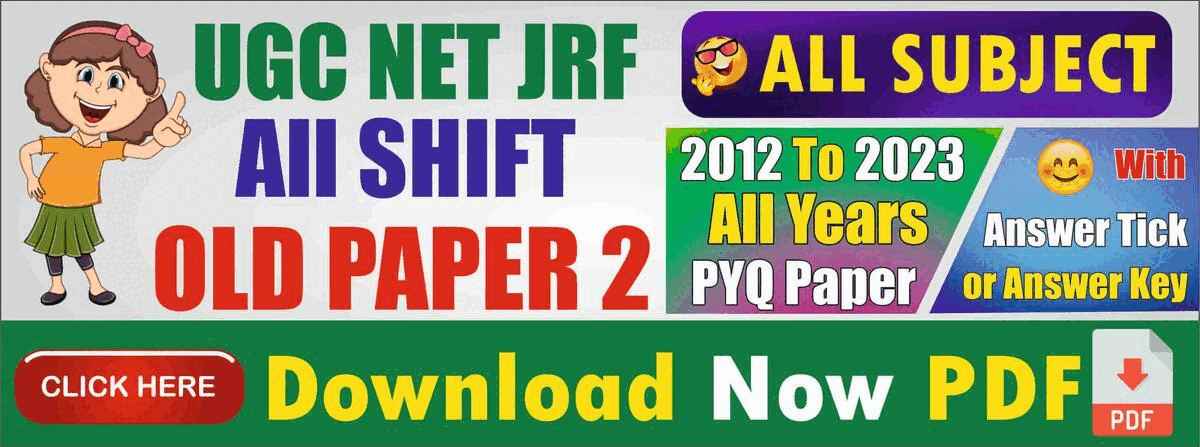Are you searching for the UGC NET Comparative Study of Religions Syllabus 2023 PDF Download? Look no further, as we have compiled all the important details and tips to help you prepare for the exam.
The UGC NET Comparative Study of Religions exam is conducted by the National Testing Agency (NTA) for candidates who wish to pursue a career in the field of Comparative Study of Religions. The exam assesses the candidates’ knowledge in the subject and tests their eligibility for lectureship and research fellowships.
If you are planning to appear for the UGC NET Comparative Study of Religions 2023 exam, it is important to have a thorough understanding of the syllabus and exam pattern. In this article, we have compiled all the important information you need to know about the UGC NET Comparative Study of Religions Syllabus 2023 PDF Download
UGC NET Comparative Study of Religions Exam Pattern 2023:
The UGC NET Comparative Study of Religions exam consists of two papers – Paper 1 and Paper 2. Both papers are conducted on the same day, and the duration of each paper is 3 hours. The exam is conducted online, and each question carries 2 marks. There is no negative marking for incorrect answers.
The UGC NET Comparative Study of Religions Exam consists of two papers: Paper 1 and Paper 2.
Paper 1:
- Duration: 3 hours
- Number of questions: 50
- Total marks: 100
- Type of questions: Multiple Choice Questions (MCQs) based on general aptitude, teaching and research aptitude, and current affairs.
Paper 2:
- Duration: 3 hours
- Number of questions: 100
- Total marks: 200
- Type of questions: MCQs based on Comparative Study of Religions subjects.
Both papers are conducted in a single session with no break in between. The candidates are required to appear for both papers to be considered for the selection process.
It’s important to note that there is no negative marking for incorrect answers in UGC NET Comparative Study of Religions Exam.
UGC NET Comparative Study of Religions Syllabus 2023: Download PDF
The UGC NET Comparative Study of Religions syllabus is divided into two parts – Paper 1 and Paper 2. Here’s a detailed syllabus for both papers.
Paper 1 Syllabus:
Teaching Aptitude:
- Teaching: Nature, objectives, characteristics, and basic requirements.
- Learner’s characteristics: Characteristics of adolescent and adult learners, and individual differences.
- Methods of teaching: Teacher-centered vs. learner-centered methods; Off-line vs. online methods.
- Evaluation systems: Elements and types of evaluation, evaluation in higher education, and grading system.
Research Aptitude:
- Research: Meaning, types, and characteristics.
- Steps of research.
- Methods of research.
- Research Ethics.
Reading Comprehension:
- Comprehension passages.
Communication:
- Communication: Nature, characteristics, types, barriers, and effective communication.
- Verbal and non-verbal communication.
- Classroom communication.
Logical Reasoning:
- Understanding the structure of arguments.
- Evaluating and distinguishing deductive and inductive reasoning.
- Verbal analogies.
Data Interpretation:
- Sources, acquisition, and interpretation of data.
- Quantitative and qualitative data.
- Graphical representation and mapping of data.
Paper 2 Syllabus:
Nta Ugc Net Comparative Study of Religions Syllabus 2023 in English
UNIT I: STUDY OF RELIGION
a. Religion: Meaning, Definition, Nature, and Scope b. Theories: Origin of Religion c. Study of Religion: Aims and objectives d. Dimensions of Religion: Doctrinal, social, moral code of conduct, devotional praxis e. Religion’s Relationship with other Disciplines: Theology, Ethics, Philosophy,
Sociology, Psychology, Culture and Arts
UNIT II: PRE-HISTORICAL RELIGIOUOS FORMS
a. Early forms of Religious Expression: Mana, Magic, Fetishes, Shamans, Totem, Taboo,
Ancestor worship b. Nature of Holy: Animism, Naturism, Theism, Polytheism, Henotheism, Deism,
Monotheism, Pantheism, and Panentheism c. Task and Objectives: Myths, Rituals, Rites of Passage, Sacraments, Prayers, Festivals,
Sacrifices d. Religion of the Major Civilizations: Indus Valley, Mesopotamian, Egyptian, Greek,
Roman, Chinese. e. Meaning and Nature: Syncretism, Mysticism, Schism, Sect, etc. f. Zoroastrianism : Beliefs and Practices
UNIT III: MODERN TRENDS IN THE STUDY OF RELIGION
a. Approaches to the Study of Religion: Anthropological, Sociological,
Phenomenological, Psychological, Historical, and Experiential. b. Challenges to Religion: Atheism, Agnosticism, Existentialism, Humanism, Marxism, Rationalism, Materialism, Secularism, Relativism, Globalization, Clash Civilizations. c. Modern Trends in the Study of Religion: Holistic or all inclusive approach, interfaith
understanding and dialogue, co-existence, human rights, empowerment of the Subaltern or social justice, gender equality, ecology and environment, world peace and harmony.
d. Religious Authority: Tradition, magician, diviner, scripture, seer, saint, reformer,
founder, prophet
UNIT IV: HINDUISM
a. Nature of Vedic Religion and Culture b. Vedic Literature – Samhita-s, Aranyak-s, Upanisad-s c. Shaivism, Vaishnavism, Shaktism, Tantraism, etc. d. Six Systems of Hindu Philosophy – Sankhya, Yoga, Nyaya, Vaisheshika, Mimamsa,
and Vedanta e. Epics (Ramayana, Mahabharata) and Purana-s f. Bhakti and Reform Movements of the Medieval Period g. Modern Reform Movements (Brahmosamaja, Aryasamaja, Ramakrishna Mission, etc.)
UNIT V: JAINISM a. Sramana Culture and Tirthankara Tradition (Rsabhadeva to Mahavira) b. Main Sects of Jainism – Digambara and Svethambara c. Prakrit Agama Literature and Prominent Acaryas d. Basic Doctrines, Principles and Philosophy e. Contribution to Arts and Arhitecture f. Social Aspects of Jainism g. Contemporary Developments of Jainism h. Jain Pilgrimage and Jain Festivals
UNIT VI: BUDDHISM
a. Background, Life and Teaching of Gautama Buddha b. Pali Tipitaka Literature and Mahayana Sutra-s c. Main Sects – Hinayana, Mahayana, etc. d. Basic Doctrines, Principles and Philosophy e. Contribution to Arts and Architecture f. Expansion of Buddhism Outside India g. Social Aspects and Revival of Buddhism
UNIT VII: JUDAISM
a. Origin and Development: Creation, the Call of Abraham, the Call of Moses, the
Exodus, the Covenant on Mount Sinai b. Hebrew Scripture: Pentateuch (Torah), Prophets (Nibium), Writings (Ketubium) c. Jewish Beliefs: Ten Commandments, Talmud, Midrash, Passover, Messiah, etc. d. Jewish Celebration: Sabbath, Synagogue Assembly, Passover, Feast of Weeks, Feast
of Tabernacles e. Jewish Ethics: Covenant consciousness, Mosaic Laws, Jubilee stipulations, marriage
and family f. Importance of Jerusalem g. Major Denomination of Judaism
UNIT VIII : CHRISTIANITY
a. The Life and Message of Jesus Christ b. The beginning of Christianity and the Sermon on the Mount c. Old Testament and New Testament Scriptures d. Main Christian Churches (Catholic, Orthodox, and Protestant) e. Important Beliefs and Teachings of Christianity f. Christian Life: Worship, Rituals, and Mysticism g. History of Christianity in India h. Contemporary Trends in Christian Theology
UNIT IX: ISLAM
a. The social, religious condition of Arabia before the advent of Islam b. Life of the Prophet Mohammad and the basic teachings of the Quran, the
establishment of the Islamic community and the Madina state. c. Introduction of Hadith and Fiqh and some important Muhaddith (Imam Bukhari,
Imam Muslim) and Faqi (Imam Abu Hanifa, Imam Shafi, Imam Malki Imam Hanbal) d. Some important Muslim thinkers: Ali ibn e Hazam, Abu Hamid al-Ghazali, ibn-e-
Taimiyah and Shah Waliullah
e. Development of Sufism, some important Sufi order’s (Chishtiyah, Qadriayah,
Suharwardiyah, Naqsbandiyah, and their impact on society f. Challenges of modernity and the reform movements among Muslim in India g. Origin and development of sects: ithna Ashari, Mutazilites and Asharits h. The contribution of Medieval Islam to Rational sciences, philosophy and fine arts.
UNIT X: SIKमHISM
a. Socio-religious milieu and life and mission of Guru Nanak b. Development of the Sikh Panth (1539-1708) c. The Sikh Scripture (Sri Guru Granth Sahib) and the Sikh Literature d. The Sikh beliefs and the code of conduct e. The Sikh institutions, ceremonies and festivals f. The Sikh sects and Modern socio-religious movements g. The Sikh diaspora and Modern Issues
Paper 2 Syllabus Download Pdf:
Ugc Net Comparative Study of Religions Syllabus 2023 in English
Ugc Net Comparative Study of Religions Syllabus 2023 in Hindi
Preparation Tips for UGC NET Comparative Study of Religions Exam 2023:
Here are some tips for preparing for the UGC NET Comparative Study of Religions exam 2023:
- Understand the syllabus and exam pattern thoroughly.
- Make a study plan
- Refer to standard textbooks and study materials recommended for the exam.
- Practice previous year question papers and mock tests.
- Focus on time management and accuracy while attempting the questions.
- Take regular breaks and maintain a healthy lifestyle to avoid burnout.
- Join coaching classes or online courses if necessary.
- Stay updated with current affairs related to the Comparative Study of Religions field.
Important Points:
- The UGC NET Comparative Study of Religions exam is conducted by NTA for candidates who wish to pursue a career in Comparative Study of Religions.
- The exam assesses the candidates’ knowledge in the subject and tests their eligibility for lectureship and research fellowships.
- The exam pattern of UGC NET Comparative Study of Religions 2023 includes multiple-choice questions and is conducted in online mode.
- The marking scheme of the exam is +2 for a correct answer and no negative marking for incorrect answers.
- The duration of the exam is 3 hours, and the number of questions is 150.
- The UGC NET Comparative Study of Religions Syllabus 2023 PDF Download is an important document that provides a detailed outline of the topics that will be covered in the exam.
- To download the syllabus, candidates can visit the official website of NTA and click on the link provided.
- The syllabus is available in PDF format and can be downloaded for free.
- The syllabus is divided into nine units, each covering a specific topic related to Comparative Study of Religions.
- To prepare for the exam, candidates must understand the syllabus, make a study plan, practice previous year question papers, join a coaching institute, take mock tests, and revise regularly.
FAQs:
- Is there any negative marking in the UGC NET Comparative Study of Religions exam 2023? Ans: No, there is no negative marking for incorrect answers.
- Can I download the UGC NET Comparative Study of Religions Syllabus 2023 PDF from the official website? Ans: Yes, the syllabus is available for download on the official website of NTA.
- What is the duration of the UGC NET Comparative Study of Religions exam 2023? Ans: The duration of each paper is 3 hours.
Also Check:
Conclusion:
In conclusion, the UGC NET Comparative Study of Religions exam 2023 is a crucial opportunity for aspirants who want to pursue a career in the teaching or research field. To crack the exam, it’s essential to have a clear understanding of the syllabus, exam pattern, and prepare accordingly. With a comprehensive understanding of the UGC NET Comparative Study of Religions Syllabus 2023 PDF download and proper preparation, you can clear the exam with flying colors.






1 thought on “[New] UGC NET Comparative Study of Religions Syllabus 2023 PDF Download”